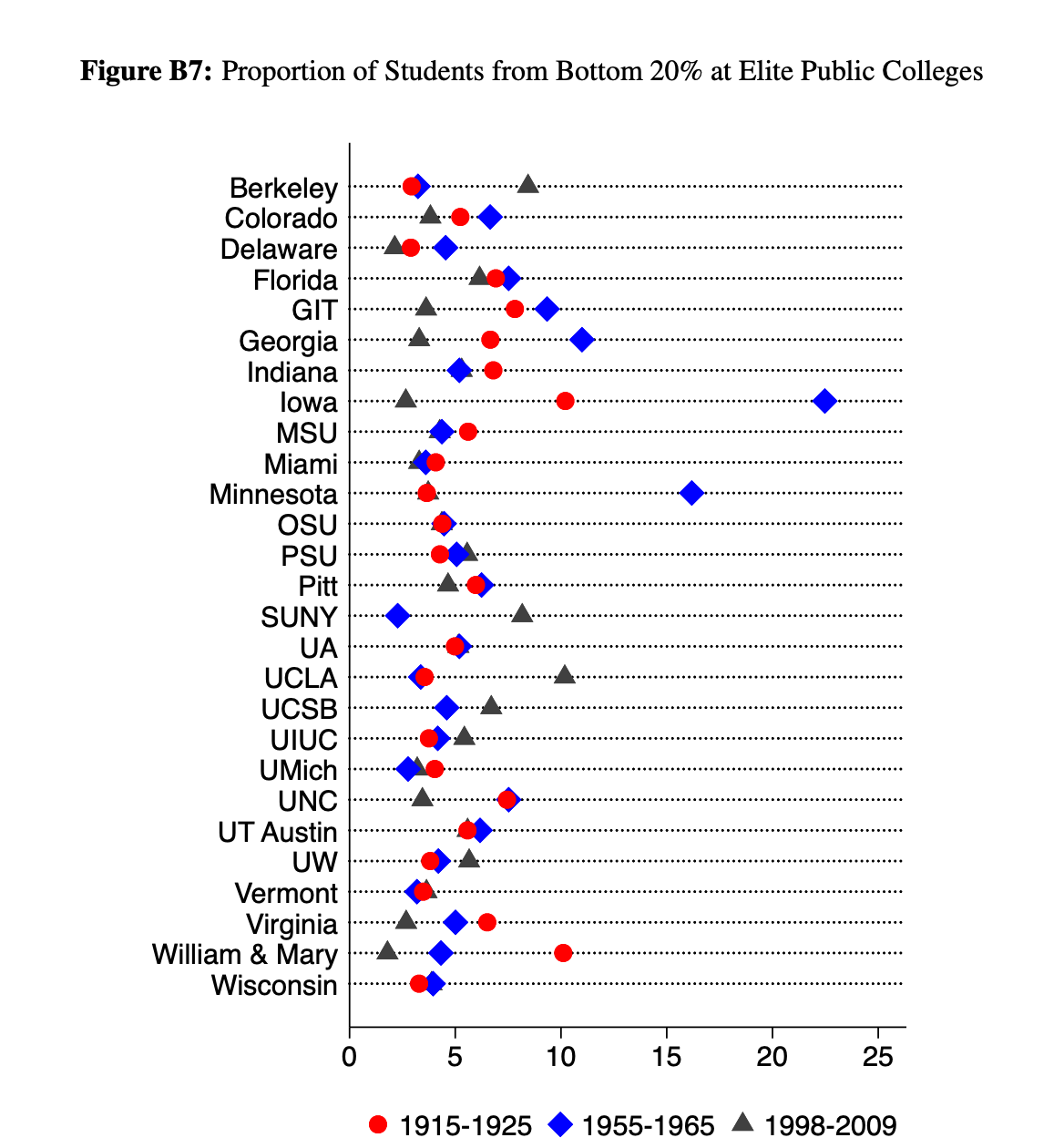The National Bureau of Economic Research recently released their detailed analysis of "the largest dataset on the socioeconomic backgrounds of students at American colleges spanning the last 100 years".
While more students from the families in the lowest 20% of parental income now enroll in college, few low-income students attend the highest status colleges.
From the paper:
The first part of our paper shows that there has been virtually no change in the representation of lower-income students at elite colleges, both private and public. Upper-income students decreased their representation at such colleges in the post-WWII period, but have since regained ground. The relative stability of the economic backgrounds of students at elite colleges contrasts with the sharp increase in students’ racial and geographic diversity at these institutions. These patterns suggest that changes in racial and geographic diversity have all taken place within the middle and upper portions of the parental income distribution. (emphasis added)
Neither the GI Bill nor the expansion of standardize admissions tests (to make admissions more "objective") made much of a difference.
For over 100 years, low-income students have been only 5% of the student body at Ivy League universities, MIT, Chicago, Duke, MIT and Stanford, and elite small private liberal arts colleges.
Elite public colleges do somewhat better but still enroll a "small and stagnant" number of students from families at the lowest 20% of parental income. At Berkeley and UCLA, "the proportion of students that come from the bottom 20% rose from less than 3% in the 1920s to 10% by the early 2000s."
From p. 89:

While comprehensive, the data for the paper ends in 2019. The authors note that a small number of campuses have introduced new "no room, board or tuition" policies for the lowest income students since 2019, but there's no clear evidence yet of how effective these are for drawing more lower-income students.
We know that pipelines are broken as early childhood and K-12 schools are unequally funded and millions of children live in poverty. We know that more privileged parents respond to uncertain times by hoarding opportunity for their own children. We know that students aspiring to college from low-income communities have too little information about actual college costs, and about positioning themselves to be strong candidates for admission.
We've known all of this for the entire century represented by the data in this study.
I absolutely do not believe that elite schools are the only places that students can access an excellent public education.
I do believe that one of the reasons that so few low-income students are admitted to the highest-status colleges is that the elite are hoarding access to the networks and higher-pay opportunities that those campuses have long opened to people like them.
And in this moment when extremely wealthy actors are dismantling public websites for dissemination of research into educational inequalities while forbidding any federal funding for new projects, I'm avoiding any links to the national data bases that I've used throughout my career, because they may be gone at any time.
And more than ever, we deeply need advocates for fairness, equity, and justice.
Because as faculty are reporting, it's getting ever more ugly:
My university has a grant to provide scholarships, mentoring, research opportunities & career support to academically talented low-income students in STEM. It’s a really fantastic & successful program. Today Ted Cruz flagged it to be cut because it’s "advanced neo-Marxist class warfare propaganda.”
— Seth Cotlar (@sethcotlar.bsky.social) February 11, 2025 at 8:42 PM
(for subscribers who read these posts on email, click through to the website if these two Bluesky posts aren't visible, since email servers sometimes strip posts of this code).
Some of the radical woke Marxist things they do in that program: - they teach students how to build credit and pay off student loans - they have alumni come talk about their career paths - they teach them how the graduate/professional school application process works
— Seth Cotlar (@sethcotlar.bsky.social) February 11, 2025 at 9:16 PM
I'm sad and furious in equal measures, and will keep documenting the long-standing structural inequalities and the ways in which educational institutions have fallen so short of equalizing opportunity. In sadness and fury, I'll keep writing about the ways in which educational institutions have been silent for too long about the breadth and depth of social class inequalities.




